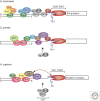Replication of telomeres and the regulation of telomerase
- PMID: 23543032
- PMCID: PMC3632062
- DOI: 10.1101/cshperspect.a010405
Replication of telomeres and the regulation of telomerase
Abstract
Telomeres are the physical ends of eukaryotic chromosomes. They protect chromosome ends from DNA degradation, recombination, and DNA end fusions, and they are important for nuclear architecture. Telomeres provide a mechanism for their replication by semiconservative DNA replication and length maintenance by telomerase. Through telomerase repression and induced telomere shortening, telomeres provide the means to regulate cellular life span. In this review, we introduce the current knowledge on telomere composition and structure. We then discuss in depth the current understanding of how telomere components mediate their function during semiconservative DNA replication and how telomerase is regulated at the end of the chromosome. We focus our discussion on the telomeres from mammals and the yeasts Saccharomyces cerevisiae and Schizosaccharomyces pombe.
Figures



References
-
- Azzalin CM, Reichenbach P, Khoriauli L, Giulotto E, Lingner J 2007. Telomeric repeat containing RNA and RNA surveillance factors at mammalian chromosome ends. Science 318: 798–801 - PubMed
Publication types
MeSH terms
Substances
Grants and funding
LinkOut - more resources
Full Text Sources
Other Literature Sources
Molecular Biology Databases
